LG Electronics USA X240Y Smart phone User Manual ZNFX240Y UserMan
LG Electronics MobileComm USA, Inc. Smart phone ZNFX240Y UserMan
ZNFX240Y_UserMan
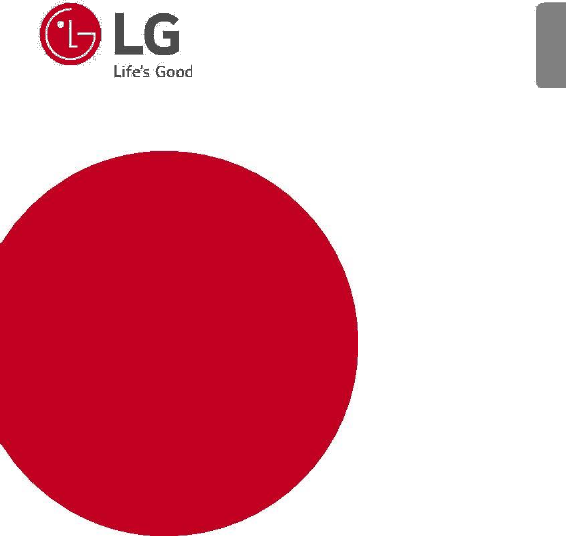
ENGLISH
USER GUIDE
LG-X240Y
MFL00000000 (1.0) www.lg.com
ENGLISH
About this user guide
Thank you for choosing this LG product. Please carefully
read this user guide before using the device for the first
time to ensure safe and proper use.
• Always use genuine LG accessories. The supplied items are designed
only for this device and may not be compatible with other devices.
• This device is not suitable for people who have a
visual impairment due to the touchscreen keyboard.
• Descriptions are based on the device default settings.
• Default apps on the device are subject to updates, and support
for these apps may be withdrawn without prior notice. If you
have any questions about an app provided with the device,
please contact a LG Service Centre. For user-installed apps,
please contact the relevant service provider.
• Modifying the device’s operating system or installing
software from unofficial sources may damage the device
and lead to data corruption or data loss. Such actions will
violate your LG licence agreement and void your warranty.
• Some content and illustrations may differ from your device,
depending on the region, service provider, software version,
or OS version, and are subject to change without prior notice.
• Software, audio, wallpaper, images, and other media
supplied with your device are licenced for limited use. If
you extract and use these materials for commercial or
other purposes, you may be infringing copyright laws. As a
user, you are fully responsible for the illegal use of media.
• Additional charges may incur for data services, such as messaging,
uploading, downloading, auto-syncing and location services. To
void additional charges, select a data plan suitable to your needs.
Contact your service provider to obtain additional details.
1
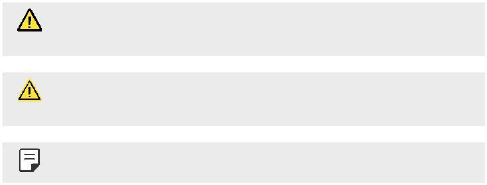
Instructional notices
WARNING: Situations that could cause injury to the
user and third parties.
CAUTION: Situations that may cause minor injury or
damage to the device.
NOTE: Notices or additional information.
About this user guide 2

Table of contents
5 Guidelines for safe and efficient use
11 Safety instructions
01
Custom-designed
Features
19 KnockON
20 Gesture shot
02
Basic Functions
22 Product components
and accessories
23 Parts overview
25 Turning on or off the power
26 Installing the SIM card
and battery
29 Charging the battery
30 Optimizing battery life
31 Inserting the memory card
32 Removing the memory card
32 Touch screen
36 Home screen
41 Screen lock
42 Device encryption
42 Taking screenshots
43 Entering text
3

03
Useful Apps
46 Installing and
uninstalling apps
47 Phone
49 Messaging
50 Camera
53 Gallery
55 File Manager
55 Clock
56 Calculator
57 Sound Recorder
57 FM Radio
57 Downloads
58 E-mail
59 Contacts
61 Calendar
62 Google apps
04
Phone Settings
65
Settings
65
Wireless & networks
70
Device
73
Personal
76
System
05
Appendix
79 LG Language Settings
79 Phone software update
80 FAQ
83 Anti-Theft Guide
84 More information
Table of contents 4

Guidelines for safe and
efficient use
Important information about the device
• Device apps and services are subject to change or cancellation without
notice, depending on the provider’s situation and the software version.
• When the device is turned on for the first time, an initial configuration
takes place. The first booting time may be longer than usual.
Read before use
• To purchase optional items, contact the LG Customer
Information Centre for available dealers.
• The appearance and specifications of the device are subject to
change without notice.
• Do not use LG products for other purposes than those
originally intended. Using non-certified apps or software may
damage the device and this is not covered by warranty.
Before you begin
Safety Guidelines
• To reduce the possibility of electric shock, do not expose your product
to high humidity areas, such as bathroom or swimming pool.
Keep the phone away from heat. Never store your phone in environment that
may expose it to temperatures below 0 °C or above 40 °C, such as outdoor
during snowstorm, or in your car in hot days. Exposure to cold or heat will
result in malfunction, damage or permanent failure. Be careful when using
your phone near other electronic devices. The RF emissions from mobile
phones may affect nearby electronic equipment that not adequately
shielded. You should consult manufacturers of any personal medical
devices, as in the case of pacemakers and hearing aides, to determine
whether they are susceptible to interference from cell phones.
5
Turn off your phone in medical facilities or at gas stations. Never place
your phone in microwaves, as it will cause the battery to explode.
Important
• Before using your phone, please read the SAFETY INFORMATION OF
THE TELECOMMUNICATIONS INDUSTRY ASSOCIATION (TIA).
Safety Information
Read these simple guidelines. Breaking the rules may be illegal or dangerous.
More detailed information is provided in this user’s guide.
• Never use an unapproved battery that could cause damages
to the phone or the battery itself, or even explode.
• Never place your phone in a microwave oven, as this will result
in an explosion of the battery.
• Do not dispose of your battery in fire or with hazardous
or flammable materials.
• Make sure the battery does not come into contact with sharp-edged
items, such as animal teeth or claws. This could cause a fire.
• Store the battery in a place out of the reach of children.
• Be careful so that children do not swallow any parts of the
phone, such as rubber plugs (earpiece, parts that connect to the
phone, etc.). This could cause asphyxiation or suffocation.
• Disconnect the plug and charger from the outlet when the
phone shows that the battery has been fully charged, because
it may cause electric shock or fire hazard.
• When in the car, do not leave your phone, or install a hands-free
kit, near the airbag. If wireless equipment is improperly installed,
you can be seriously injured if the airbag is deployed.
• Do not use mobile phone while driving.
Guidelines for safe and efficient use 6
• Do not use the phone in areas where its usage is prohibited.
(For example: in airplanes).
• Do not expose the battery charger or adapter to direct sunlight, or
use it in places with high humidity, such as bathroom.
• Never store your phone in temperatures lower than -20 °C or
higher than 50 °C.
• Do not use harsh chemicals (such as alcohol, benzene, solvents,
etc.) or detergents to clean the phone. This could cause fire.
• Do not drop the phone, strike it, or shake it hard.
Such actions may harm the phone’s internal circuit boards.
• Do not use your phone in high explosive areas, as this may generate sparks.
• Do not damage the power cord by bending, twisting, pulling, or heating
it. Do not use the plug if it is loose as it may cause fire or electric shock.
• Do not handle the phone with wet hands while it is charging. This
can cause electric shock or seriously damage your phone.
• Do not disassemble the phone.
• Do not make or answer calls while charging the phone, which
can cause a short circuit, electric shock, or fire.
• Use only batteries and chargers provided by LG. The warranty
does not apply to products provided by other providers.
• Only authorized personnel should service the phone and its accessories.
• Installation or service may result in accidents and consequently
invalidate the warranty.
• Do not hold or let the antenna come in contact with your body during a call.
• Emergency calls can be made only within a service area. To make an
emergency call, make sure you are within a service area and the phone is on.
• Use your accessories, such as headphones or headsets, with
caution, ensuring that the cables are plugged properly and that
they do not touch the antenna unnecessarily.
• Do not use your device near medical equipment without requesting
permission. Please consult your doctor to determine if operation of
your device may interfere with the operation of your medical device.
Guidelines for safe and efficient use 7

Information about the RF exposure from FCC
• Read this information before operating the phone.
In August 1996, the Federal Communications Commission (FCC) of the United
States, with its action in Report and Order FCC 96-326, adopted an updated
safety standard for human exposure to radio frequency (RF) electromagnetic
energy emitted by FCC regulated transmitters. Those guidelines are consistent
with the safety standard previously set by both international and U.S. standards.
The highest SAR value for this phone FCC tested for use in the ear is 0.98 W/kg,
and when worn on the body is 1.13 W/kg. The design of this phone complies with
FCC guidelines and these international standards.
Body effects
This device was tested for typical body operation, keeping a distance of 1.5 cm
(0.59 inch) between the user’s body and the front and back of the phone. To
comply with RF exposure requirements of the FCC standards, a minimum
distance of 1.5 cm (0.59 inch) between the user’s body and the front and back of
the phone is required.
Belt-clips, holsters, and similar accessories containing metallic
components from others manufacturers should not be used.
Accessories worn close to the body, without keeping a minimum distance
of 1.5 cm (0.59 inch) between the user’s body and the front and back of the
phone, and that have not been tested for typical body operation, may not
comply with FCC’s RF exposure limits and should be avoided.
Class B Compliance under article 15 of the FCC
This device and its accessories comply with Article 15 of the FCC rules.
The operation is subject to the following conditions:
(1) This device, and its accessories, will not cause harmful interference
and (2) this device and its accessories must accept any interference
received, including interference that could cause an undesired operation.
Battery Precautions
• Do not disassemble.
• Do not short-circuit.
• Do not expose to high temperatures, over 60 °C (140 °F).
Guidelines for safe and efficient use
8
• Do not incinerate.
Battery Disposal
• Please dispose of your battery properly, or bring it to your
wireless provider for recycling.
• Do not dispose of your battery in fire or with hazardous
or flammable materials.
Adapter Precautions (Charger)
• Using the wrong battery charger could damage your phone
and void your warranty.
• The adapter or battery charger is only designed for indoor use.
• Do not expose the battery charger or adapter to direct sunlight, or
use it in places with high humidity, such as the bathroom.
Cautions for Battery
• Do not disassemble or open crush, bend or deform, puncture or shred.
• Do not modify or remanufacture, attempt to insert foreign
objects into the battery, immerse or expose to water or other
liquids, expose to fire, explosion or other hazard.
• Only use the battery for the system for which it is specified.
• Only use the battery with a charging system that has been qualified with
the system per this standard. Use of an unqualified battery or charger may
present a risk of fire, explosion, leakage, or other hazard.
• Do not short circuit a battery or allow metallic conductive
objects to contact battery terminals.
• Replace the battery only with another battery that has been qualified with
the system per this standard, IEEE-Std-1725. Use of an unqualified
battery may present a risk of fire, explosion, leakage or other hazard.
• Promptly dispose of used batteries in accordance with local regulations.
• Battery usage by children should be supervised.
• Avoid dropping the phone or battery. If the phone or battery is
dropped, especially on a hard surface, and the user suspects
damage, take it to a service center for inspection.
• Improper battery use may result in a fire, explosion or other hazard.
Guidelines for safe and efficient use 9
• For those host devices that utilize a USB port as a charging source,
the host device’s user manual shall include a statement that the
phone shall only be connected to products that bear the USB-IF logo
or have completed the USB-IF compliance program.
• Always unplug the charger from the wall socket after the phone is fully
charged to save unnecessary power consumption of the charger.
Avoid damage to your ear
• Damage to your hear can occur due to constant exposure to
excessive high sound. We, therefore, recommend that you do not
turn on or off the phone near your ear. We also recommend you
be reasonable with the music and volume level.
• If you listen to music, please ensure that the volume level is
adequate, so that you are aware of your surroundings. This is
particularly important when attempting to cross a street.
FCC Part 15.21 statement
Any changes or modifications not expressly approved by the party responsible for
compliance could void the user’s authority to operate this equipment.
FCC Part 15.105 statement
This equipment has been tested and found to comply with the limits for
a Class B digital device, pursuant to part 15 of the FCC Rules.
These limits are designed to provide reasonable protection against harmful
interference in a residential installation. This equipment generates, uses and can
radiate radio frequency energy and, if not installed and used in accordance with
the instructions, may cause harmful interference to radio communications.
However, there is no guarantee that interference will not occur in a particular
installation. If this equipment does cause harmful interference to radio or
television reception, which can be determined by turning the equipment off and
on, the user is encouraged to try to correct the interference by one
or more of the following measures:
• Reorient or relocate the receiving antenna.
• Increase the separation between the equipment and receiver.
• Connect the equipment into an outlet on a circuit different from
that to which the receiver is connected.
• Consult the dealer or an experienced radio/TV technician for help.
Guidelines for safe and efficient use 10
Safety instructions
TIA’s Safety Information
This includes complete security information on wireless phones
from TIA (Telecommunications Industry Association).
It’s required, for CTIA Certification, the inclusion in the user manual of
text covering pacemakers, hearing aids and other medical devices. It’s
encouraged the use of the remaining TIA language when relevant.
Exposure to Radio Frequency Signal
Your wireless handheld portable telephone is a lowpower radio transmitter and receiver.
When it is ON, it receives and also sends out radio frequency (RF) signals.
In August, 1996, the Federal Communications Commissions (FCC) adopted RF
exposure guidelines with safety levels for handheld wireless phones. Those
guidelines are consistent with the safety standards previously set
by both U.S. and international standards bodies:
ANSI C95.1 (1992) *
NCRP Report 86 (1986)
ICNIRP (1996)
Those standards were based on comprehensive and periodic evaluations of the
relevant scientific literature. For example, over 120 scientists, engineers, and
physicians from universities, government health agencies, and industry reviewed
the available body of research to develop the ANSI Standard (C95.1).
* American National Standards Institute; National Council on
Radiation Protection and Measurements; International
Commission on Non-Ionizing Radiation Protection.
The design of your phone complies with the FCC guidelines (and those standards).
Phone Operation
NORMAL POSITION: Hold the phone as you would any other
telephone with the antenna pointed up and over your shoulder.
Safety instructions 11
Suggestions for a more efficient operation
For your phone to operate most efficiently:
• Do not touch the antenna unnecessarily, when the phone is in use. The
contact with the antenna affects call quality, and may cause the phone to
operate at a higher power level than otherwise would be need.
Driving
Check the laws and regulations related to the use of wireless
phones in the areas where you drive. Always obey these
regulations. Also, if using your phone while driving, make sure to:
• Pay full attention to driving; driving safely is your first responsibility;
• Use hands-free operation, if available;
• Pull off the road and park, before making or answering a
call, if driving conditions demand so.
Electronic Devices
Most modern electronic equipment is shielded from RF signals.
However, certain electronic equipment may not be shielded against
the RF signals from your wireless phone.
Pacemaker
The Medical Industry Manufacturers Association recommends a minimum distance
of fifteen (15) centimeters, or six (6) inches, between a handheld wireless phone
and a pacemaker, in order to avoid potential interference between them.
These advices are consistent with independent researches, and
with recommendations based on wireless technology research.
People with pacemakers should:
• Always keep the product more than six (6) inches from their
pacemaker when the product is turned ON.
• Not carry the phone in a shirt pocket.
• Use the ear opposite to the pacemaker, to minimize the potential interference.
• If you have any reason to suspect that interference is taking
place, switch off your phone immediately.
Safety instructions 12
Hearing Aids
Some digital wireless phones may interfere with some hearing aids. In the event of
such interference, we recommend that you contact your service provider.
Other Medical Devices
If you use any other personal medical devices, consult your device
manufacturer to determine if they are adequately shielded from external
RF energy. Your doctor can help you obtain this information.
Health Care Facilities
Turn off your phone in health care facilities, whenever there are
signs asking you to do so. Hospitals or health care facilities may
use equipment that could be sensitive to external RF energy.
Vehicles
RF signals may affect improperly installed or inadequately
shielded devices in motor vehicles.
Check with the manufacturer, or its representative, regarding your vehicle.
You should also consult the manufacturer about any equipment
that has been added to your vehicle.
Facilities with signs
Turn off the phone in any facility where warning signs request you to do so.
Airplanes
FCC regulations prohibit the use of phones while in the air.
Turn off your phone before boarding an airplane.
Blasting Areas
To avoid interfering with blasting operations, turn your phone off
when in a ‘blasting area’ or in areas with signs that read: ‘Turn off
two-way radios’ . Obey all signs and instructions.
Safety instructions 13
Potentially Explosive Atmosphere
Turn off the phone when in an area with a potentially explosive
atmosphere, and obey all signs and instructions.
Sparks in such areas could cause an explosion or fire that could
result in personal injury or death.
Areas with a potentially explosive atmosphere are often clearly
marked, but not always. Among the potentially dangerous areas are:
Fueling areas (such as gas stations), areas below deck on boats, facilities
where chemical products are transferred or stored, vehicles using liquefied
petroleum gas (as propane or butane), areas where the air contains
chemicals or particles (such as grain, dust or metal powders), and any other
areas where you would normally be advised to turn off your vehicle engine.
For vehicles equipped with air bags
Air bags inflate with strong force. Do not place objects in the
area over the air bag or in its deployment area, including
wireless equipment, either installed or portable.
Serious injuries could occur if wireless equipment is improperly
installed into the car when the air bag inflates.
Safety Information
Read and observe the following information for the safe and
proper use of your phone, and to prevent any damage.
Also, keep the user’s guide in an accessible place at all times after reading it.
Charger, Adapter and Battery Security
• The charger and adapter are designed only for indoor use.
• Dispose of your battery properly, or bring it to your wireless
provider for recycling.
• The battery doesn’t need to be fully discharged before recharging.
• Only use LG approved chargers that are specifically made for your
phone model, since they are designed to maximize the battery life.
• Do not disassemble or short-circuit it.
• Keep the metal contacts on the battery clean.
Safety instructions 14
• Replace the battery when it no longer provides acceptable performance. The
battery can be recharged several hundred times before replacement.
• Charge the battery after long periods without use to maximize its life.
• The battery life will vary depending on usage patterns and
environmental conditions.
• Intensive use of backlighting, browser, and packet data
connectivity affect battery life and talk/standby times.
• The role of self-protection interrupts the phone when its
operation is in an abnormal state. In this case, remove the
battery from the phone, reinstall it, and turn on the phone.
Explosion, Shock and Fire Danger
• Do not place the phone in a place exposed to excessive dust, and keep
the minimum required distance between the power cord and heat sources.
• Unplug the power cord before cleaning the phone, and clean
the power plug whenever it is dirty.
• When using the power plug, make sure it is firmly connected.
Otherwise, it can overheat or start a fire.
• Placing the phone in a pocket or bag without covering the receptacle
(power plug pin), metallic articles (such as a coin, clip or pen) may
short-circuit the phone. Always cover the receptacle when not in use.
• Do not short-circuit the battery. Metal items, such as coins, paper clips, or
pens, in your pocket or bag may cause a shortcircuit between the + and -
terminals of the battery (metal strips on the battery). The short-circuit of
the terminals may damage the battery and cause an explosion.
General Notice
• Using a damaged battery, or inserting it into the mouth can
cause serious injuries.
• Do not place the phone in proximity to items containing magnetic components,
such as credit cards, calling cards, bank books, or subway tickets. The phone
magnetism may damage the data stored in the magnetic strip.
• Talking on the phone for a long period of time may reduce call
quality, because of the heat generated during use.
Safety instructions 15
• When the phone has not been in use for a long time, store it
in a safe place, with the power cord unplugged.
• Using the phone close to a receiving equipment (such as TV
or radio) may cause interference.
• Do not immerse your phone in water. If this happens,
immediately turn it off and remove the battery. If your phone
does not work, take it to an LG Authorized Service Facility.
• The power supply contains elements that could be harmful to
your health, if components are handled directly. If this
happens, we recommend immediate hand-washing.
• Do not paint the phone.
• Data stored in your phone might be deleted due to careless use, hardware
repair or software upgrade. Please backup your important phone numbers
(ringtones, text or voice messages, images, and videos might also get deleted).
The manufacturer is not liable for damages due to loss of data.
• When using the phone in public places, you may set the
ringer on vibrate to avoid disturbing others.
• Do not switch the phone on/off while it is in your ear.
• Repairs under warranty, at LG’s discretion, may include replacement
parts or boards that are either new or reconditioned, provided that
they have functionality equal to that of the parts being replaced.
• Please ensure that the product does not get in contact with liquid. Do not use
or recharge the product if it is wet. Once the product becomes wet, the liquid
damage indicator changes color. Please note that this will limit you from
receiving any free-of-charge repair services provided under warranty.
Precautions when using SIM cards
• Do not insert the SIM card into the device with the label or seal
attached. This may cause damage.
• Do not remove the SIM card while using the device. This may
damage the SIM card or the system.
• Take extra care to ensure that the SIM card is not scratched,
bent, or damaged by magnet. This may delete files saved on the
SIM card or cause device malfunctions.
Safety instructions 16
Precautions when using memory cards
• Make sure that the orientation is correct when inserting the memory
card. Inserting using the wrong orientation may damage the card.
Ambient temperatures
Use your phone in temperatures between 0 ºC and 40 ºC, if possible.
Exposing your phone to extremely low or high temperatures may
result in damage, malfunction, or even explosion.
Securing personal information
• Make sure to protect your personal information to prevent
data leakage or misuse of sensitive information.
• Always back up important data while using the device. LG is not
responsible for any data loss.
• Make sure to back up all data and reset the device when disposing
of the device to prevent any misuse of sensitive information.
• Read the permission screen carefully while downloading applications.
• Be cautious using the applications that have access to multiple
functions or to your personal information.
• Check your personal accounts regularly. If you find any sign of
misuse of your personal information, ask your service provider
to delete or change your account information.
• If your device is lost or stolen, change the password of your
account to secure your personal information.
• Do not use applications from unknown sources.
Safety instructions 17

01
Custom-designed
Features

KnockON
You can turn the screen on or off by double-tapping the screen.
• This option is available only on the Home screen provided
by LG. It may not function properly on a custom launcher
or on the Home screen installed by the user.
• When tapping the screen, use your fingertip. Do not use a fingernail.
• To use the KnockON feature, make sure that the proximity/light
sensor is not blocked by a sticker or any other foreign substance.
Turning on the screen
Double-tap the middle of the screen.
• Tapping the top or bottom of the screen may decrease
the recognition rate.
Turning off the screen
Double-tap the status bar, an empty area on the Home
screen or the Lock screen.
Custom-designed Features 19

Gesture shot
You can take selfies by using gestures.
Show your palm to the front camera and then clench your fist.
• In three seconds, a photo is taken.
• An alternative way to take gesture shots is to clench your
fist and then open it towards the front camera.
• Make sure that your palm and fist are within the reference
line so that the camera can detect them.
Custom-designed Features 20

02
Basic Functions

Product components
and accessories
Make sure that none of the following items are missing:
•
Device
•
USB cable
•
Battery
•
Charger
•
Stereo headset
•
Quick Start Guide
• The items described above may be optional.
• The items supplied with the device and any available accessories
may vary depending on the area and service provider.
• Always use genuine LG Electronics accessories. Using accessories
made by other manufacturers may affect your device's call performance
or cause malfunctions. This may not be covered by LG's repair service.
• If any of these basic items are missing, contact the
dealer from which you purchased your device.
• To purchase additional basic items, contact the LG
Customer Service Centre.
• To purchase optional items, contact the LG Customer
Service Centre for available dealers.
• Some items in the product box are subject to change without notice.
• The appearance and specifications of your device are
subject to change without notice.
Basic Functions 22

Parts overview
Microphone
Front Camera Lens
Volume Keys
Microphone
Rear Camera Lens
Power/Lock Key
Headset Jack
Earpiece
Proximity/Ambient Light
Sensor
Charger/USB Port
Flash
Speaker
Microphone
Basic Functions 23

• Proximity/Ambient Light Sensor
- Proximity sensor: The proximity sensor turns off the screen and
disables touch functionality when the device is in close proximity
to the human body. It turns the screen back on and enables
touch functionality when the device is outside a specific range.
- Ambient light sensor: The ambient light sensor
analyses the ambient light intensity when the auto-
brightness control mode is turned on.
• Volume Keys
- Adjust the Volume for ringtones, calls or notifications.
- Gently press a Volume key to take a photo.
- While screen is off, long press a Volume key to launch Camera.
• Power/Lock Key
- Briefly press the key when you want to turn the screen on or off.
- Press and hold the key when you want to select a
power control option.
• Some functions may be restricted for access, depending
on the device specifications.
• Do not put heavy objects on the device or sit on it, as this
may damage the screen.
• Screen-protective film or accessories may interfere with
the proximity sensor.
• If your device is wet or is being used in a humid place, the
touch sensor or buttons may not function properly.
Basic Functions 24

Turning on or off the power
Turning on the power
When the power is turned off, press and hold the Power/Lock Key.
• When the device is turned on for the first time, initial
configuration takes place. The first booting time for the
smart phone may be longer than usual.
Turning off the power
Press and hold the Power/Lock Key, then select Power off.
Power control options
Tap and hold the Power/Lock Key, then select an option.
• Power off: Turn off the device.
• Restart: Restart the device.
Basic Functions 25

Installing the SIM card and battery
Insert the SIM card provided by the device service
provider, and the included battery.
• Do not insert a memory card into the SIM card slot. If a memory
card happens to be lodged in the SIM card slot, take the device
to a LG Service Centre to remove the memory card.
• Only the Nano SIM cards work with the device.
1 To remove the back cover, hold the device firmly in one
hand. With your other hand, lift off the back cover with
your thumbnail as shown in the figure.
Basic Functions 26

2 Slide the SIM card into the SIM card slot as shown in the figure.
Make sure the gold contact area on the card is facing downward.
• To remove the SIM Card from Slot 1, push the pin at the top to the left.
Basic Functions 27
3 Insert the battery.
4 To replace the cover onto the device, align the back cover over the
battery compartment and press it down until it clicks into place.
Basic Functions 28

Charging the battery
Charge the battery before using it for first time. Use the charger
to charge the battery. A computer can also be used to charge
the battery by connecting the device to it using the USB cable.
• Use only LG-approved chargers, batteries and cables. If you use
unapproved chargers, batteries or cables, it may cause battery
charging delay. Or this can cause the battery to explode or
damage the device, which are not covered by the warranty.
The charger connector is located at the bottom of the
device. Insert the charger and plug it into a power outlet.
Basic Functions 29
Optimizing battery life
Extend your battery’s power by turning off features that you do not
need to run constantly in the background. You can monitor how
applications and system resources consume battery power.
Extending your device battery life
• Turn off radio communications when you are not using. If
you are not using Wi-Fi, Bluetooth® or GPS, turn them off.
• Reduce screen brightness and set a shorter screen timeout.
• Turn off automatic syncing for Gmail, Calendar,
Contacts and other applications.
• Some applications you download may consume battery power.
• While using downloaded applications, check the battery charge level.
Basic Functions 30

Inserting the memory card
The device supports up to a 32GB microSD. Some
memory cards may not be compatible with your device,
depending on the memory card manufacturer and type.
• Some memory cards may not be fully compatible with the
device. If you use an incompatible card, it may damage the
device or the memory card, or corrupt the data stored in it.
• If you write and erase data too frequently, it will shorten
the lifespan of memory cards.
1 Remove the back cover.
2 Insert a memory card with the gold-coloured
contacts facing downwards.
3 Replace the back cover.
Basic Functions 31
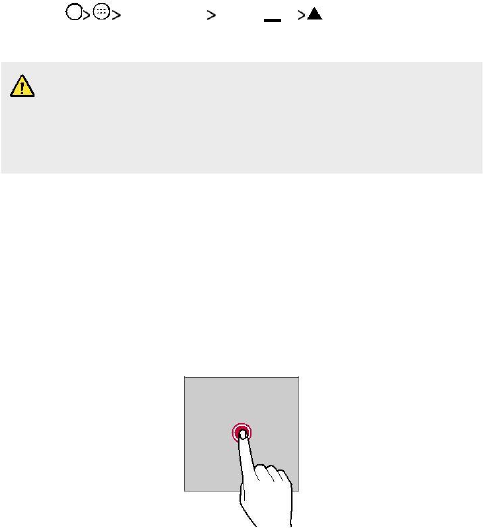
Removing the memory card
Before removing the memory card, first unmount it for safe removal.
1 Tap Settings Storage .
2 Remove the back cover and pull out the memory card.
• Do not remove the memory card while the device is transferring
or accessing information. This may cause data to be lost or
corrupted, or may damage the memory card or the device. LG is
not responsible for losses that result from the abuse or improper
use of memory cards, including the loss of data.
Touch screen
You can familiarise yourself with how to control your
device by using touch screen gestures.
Tapping
Lightly tap with your fingertip to select or run an app or option.
Basic Functions 32

Tapping and holding
Tap and hold for several seconds to run a hidden function.
Double-tapping
Tap twice quickly to zoom in or out on a photo or map.
Swiping
Tap and hold an item, such as an app or widget, then swipe it
to another location. You can use this gesture to move an item.
Basic Functions 33
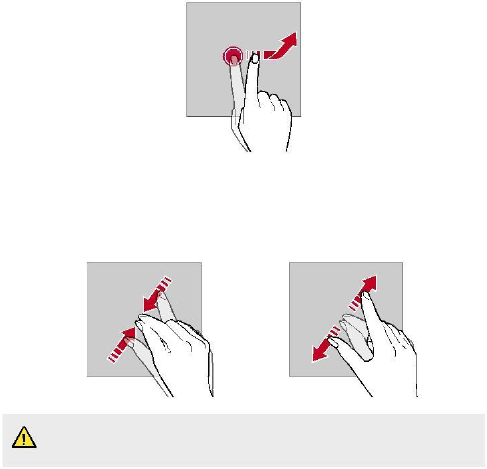
Flicking
Gently tap and hold on the screen, then flick left or right to
quickly move to another panel.
Pinching and spreading
Pinch two fingers to zoom out such as on a photo or
map. To zoom in, spread your fingers apart.
• Do not expose the touch screen to excessive physical
shock. You might damage the touch sensor.
Basic Functions 34

• A touch screen failure may occur if you use the device
near a magnetic, metallic or conductive material.
• If you use the device under bright lights, such as direct sunlight,
the screen may not be visible, depending on your position. Use
the device in a shady location or a location with an ambient light
that is not too bright and bright enough to read books.
• Do not press the screen with excessive force.
• Gently tap with your fingertip on the option you want.
• Touch control may not work properly if you tap while
wearing a glove or by using the tip of your fingernail.
• Touch control may not work properly if the screen is moist or wet.
• The touch screen may not function properly if a screen-
protective film or accessory is attached to the device.
Basic Functions 35
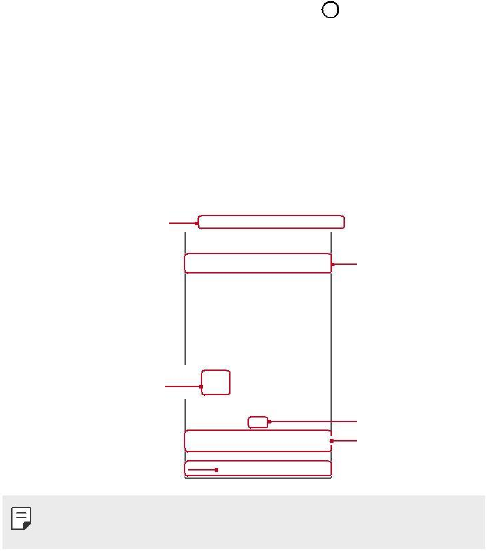
Home screen
Home screen overview
The Home screen is the starting point for accessing various
functions and apps on your device. Tap on any screen to
directly go to the Home screen.
You can manage all apps and widgets on the Home screen. Swipe
the screen left or right to view all installed apps at a glance.
To search for an app, use Google search.
Home screen layout
You can view all apps and organise widgets and folders
on the Home screen.
Status bar
Widget
Folder
Page icon
Quick access area
Home touch buttons
• The Home screen may vary, depending on the
service provider or software version.
• Status bar: View status icons, the time and the battery level.
• Widget: Add widgets to the Home screen to quickly access
necessary information without bothering to run apps one by one.
Basic Functions 36

• Folder: Create folders to group apps by your preferences.
• Page icon: View the total number of Home screen canvases
and the currently displayed canvas which is highlighted.
• Quick access area: Fix main apps at the bottom of the screen
so that they can be accessed from any Home screen canvas.
• Home touch buttons
- : Return to the previous screen. Close the
keypad or pop-up windows.
- : Tap to go to the Home screen. To launch Google, tap and hold.
- : View a list of recently used apps or run an app from the list.
In some apps, tapping and holding the button
will access additional options.
Status icons
When there is a notification for an unread message,
calendar event or alarm, the status bar displays the
corresponding notification icon. Check your device's status
by viewing notification icons displayed on the status bar.
• : No signal
• : Data is being transmitted over the network
• : Alarm is set
• : Vibrate mode is on
• : Bluetooth is on
• : Connected to a computer via USB
• : Flight mode is on
• : Missed calls
• : Wi-Fi is on
• : Hotspot is on
• : No SIM card
Basic Functions 37
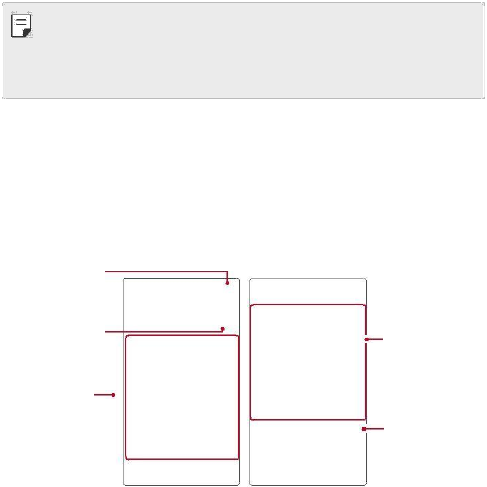
• Some of these icons may appear differently or may not appear at all,
depending on the device's status. Refer to the icons according to the
actual environment in which you are using the device.
• Displayed icons may vary, depending on the area or service providers.
Notifications panel
You can open the notifications panel by dragging
the status bar downwards.
Use quick access icons in the notifications panel to easily
and quickly turn a function on or off.
Access the
Settings app.
Adjust the
brightness.
View notifications.
View quick access
icons. Delete
notifications.
Basic Functions 38

Switching the screen orientation
You can set the screen orientation to automatically switch,
according to the device's orientation.
On the notification panel, tap Portrait from the quick access icon list.
Alternatively, tap Settings Display When device is
rotated and select Rotate the contents of the screen.
Editing the Home screen
On the Home screen, tap and hold on an empty space,
then start the desired function.
• To rearrange the Home screen canvases, tap and
hold on a canvas, then drag it to another location.
• To add widgets to the Home screen, tap WIDGETS and
drag a widget to the Home screen.
• To change Home screen settings, tap SETTINGS
and customise options.
Basic Functions 39
Moving apps on the Home screen
On the Home screen, tap and hold an app, then drag
it to another location.
• To keep frequently used apps at the bottom of the Home screen, tap and
hold an app, then drag it to the quick access area at the bottom.
• To remove an icon from the quick access area, drag
the icon to the Home screen.
Using folders from the Home screen
Creating folders
On the Home screen, tap and hold an app, then drag it over another app.
• A new folder is created and the apps are added to the folder.
Editing folders
On the Home screen, tap a folder and then run the desired function.
• To edit the folder name, tap the folder name.
• To remove an app from the folder, tap and hold the
app and drag it to outside the folder. If only one app is
left in the folder, the folder disappears automatically.
Basic Functions 40
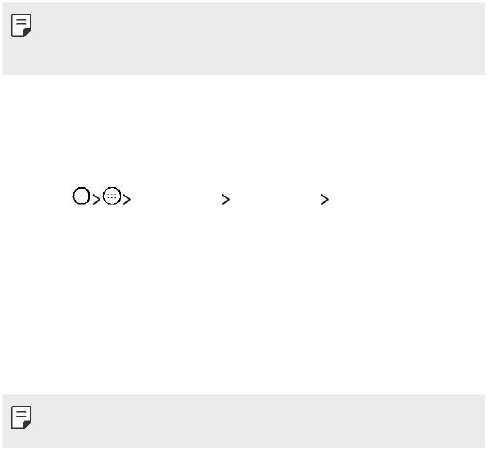
Screen lock
Screen lock overview
Your device's screen turns off and locks itself if you
press the Power/ Lock Key. This also happens after the
device is left idle for a specified period of time.
If you press the Power/Lock Key when a screen lock is not
set, the Home screen appears immediately.
To ensure security and prevent unwanted access to
your device, set a screen lock.
• Screen lock prevents unnecessary touch input on the device
screen and reduces battery consumption. We recommend that
you activate the screen lock while not using the device.
Configuring screen lock settings
There are several options available for configuring
the screen lock settings.
1 Tap Settings Security Screen lock and
then select the method you prefer.
2 Customise lock settings:
• None: Deactivate the screen lock function.
• Swipe: Slide on the screen to unlock the screen.
• Pattern: Draw a pattern to unlock the screen.
• PIN: Enter a numeric password to unlock the screen.
• Password: Enter an alphanumeric password to unlock the screen.
• If you incorrectly attempt to unlock the device 5 times,
the screen is blocked for 30 seconds.
Basic Functions 41

Device encryption
Encrypting your device
Data is encrypted before saving on the device to protect the data. It is
possible to read, write and copy data even when device encryption is
set. It is also possible to display a user confirmation prompt when the
power is turned on by using lock settings while in lock screen mode.
Precautions for device encryption
You can use Secure start-up to increase your device’s protection level.
• If Secure start-up is turned on and an incorrect
password is entered more than a specified number of
times, the device will automatically initialise.
• If you forget your decryption password, you must initialise the device to
use it again. Initialisation will delete all data saved before initialisation.
Taking screenshots
You can take screenshots of the current screen you are viewing.
Via a shortcut
Press and hold the Power/Lock Key and the Volume Down
(-) key at the same time for at least two seconds.
• Screenshots can be viewed from the Screenshot folder in the Gallery.
Basic Functions 42
Entering text
Using Smart keyboard
You can use Smart keyboard to enter and edit text.
With Smart keyboard, you can view text as you type without bothering to
alternate between the screen and a conventional keyboard. This allows
you to easily find and correct errors when typing.
Suggesting words
Smart keyboard automatically analyses your usage patterns
to suggest frequently used words as you type. The longer you
use your device, the more precise the suggestions are.
• The selected word is automatically entered. You do
not need to manually type every letter of the word.
Basic Functions 43
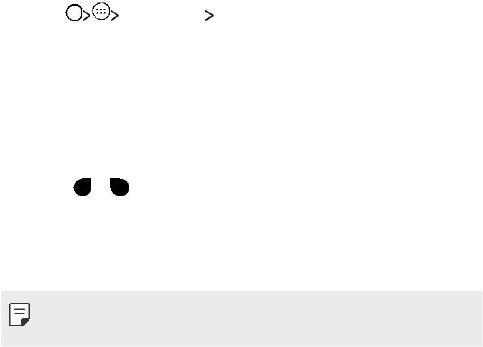
Changing the keyboard
You can change the input language and the keyboard
type for each language.
1 Tap Settings Language & input.
2 Select a language and customise the keyboard type.
Copy and Paste
You can cut or copy text from an app, and then paste the text into the
same app. Or, you can run other apps and paste the text into them.
1 Tap and hold around the text you want to copy or cut.
2 Drag / to specify the area to copy or cut.
3 Select either CUT or COPY.
• Cut or copied text is automatically added to the clip tray.
4 Tap and hold the text input window, then select PASTE.
• If there is no item that has been copied or cut, the
PASTE option will not appear.
Basic Functions 44

03
Useful Apps
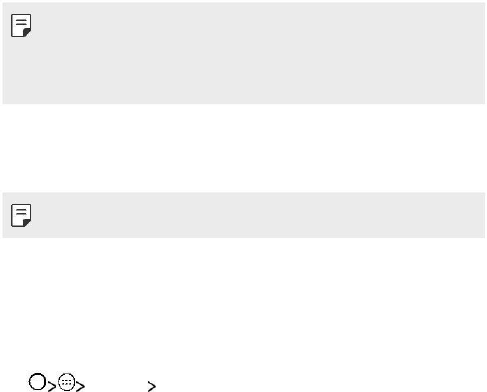
Installing and uninstalling apps
Installing apps
Access an app store to search and download apps.
• You can use Play Store or the app store provided by
your service provider.
• Some app stores may require you to create an account and sign in.
• Some apps may charge fees.
• If you use mobile data, you may be charged for data
usage, depending on your pricing plan.
Uninstalling apps
Uninstall apps that you no longer use from your device.
• Some apps cannot be uninstalled by users.
Uninstalling with the tap and hold gesture
• On the Home screen, tap and hold the app to uninstall,
then drag it over Uninstall at the top of the screen.
Uninstalling by using the settings menu
Tap Settings Apps, select an app, then tap UNINSTALL.
Uninstalling apps from the Play Store
To uninstall an app, access the Play Store from which you
download the app and uninstall it.
Useful Apps 46
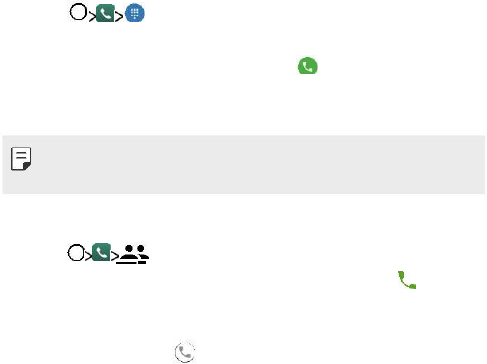
Phone
Voice call
Make a phone call by using one of the available methods,
such as manually entering a phone number or making a
call from the contact list or the list of recent calls.
Making a call from the keypad
1 Tap .
2 Make a call by using a method of your choice:
• Enter a phone number and tap .
• Search for a contact by tapping the initial letter of a
contact name in the contact list.
• To enter "+" when making an international call, tap and hold number 0.
• The headsets will continue to play sound even in Speaker Mode.
Making a call from the contact list
1 Tap .
2 From the contact list, select a contact and tap .
Answering a call
To answer a call, swipe to right to answer an incoming call.
• When the stereo headset is connected, you can make
calls by using the call/end button on the headset.
Useful Apps 47
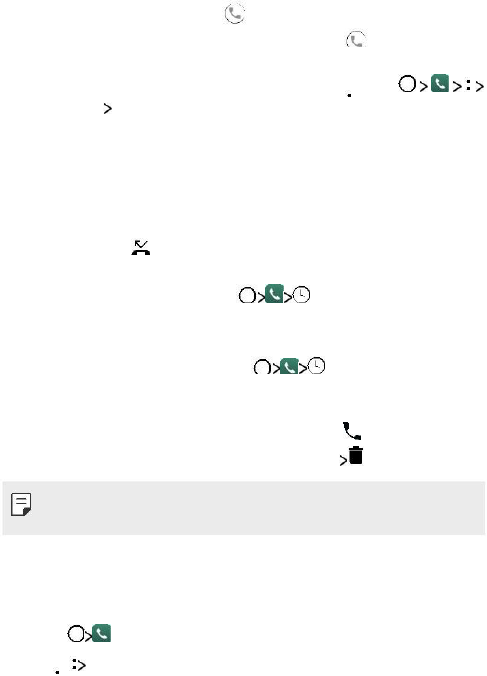
Rejecting a call
To reject an incoming call, swipe to left to decline an incoming call.
• To send a rejection message, swipe to up to
send a rejection message.
• To add or edit a rejection message, tap
Settings Quick responses.
• When a call is coming in, you can press the Power/Lock
Key or the volume key to switch to mute mode.
Viewing missed calls
If there is a missed call, the status bar at the top of the
screen displays .
To view missed call details, drag the status bar
downwards. Alternatively, tap .
Viewing call records
To view recent call records, tap . Then, you
can use the following functions:
• To view detailed call records, select a contact. To
make a call to the selected contact, tap .
• To delete call records, tap Call details .
• The displayed call duration may differ from the call charge.
Consult with your service provider for more information.
Configuring call options
You can configure various call options.
1 Tap .
2 Tap Settings and then configure the options
to suit your preferences.
Useful Apps 48
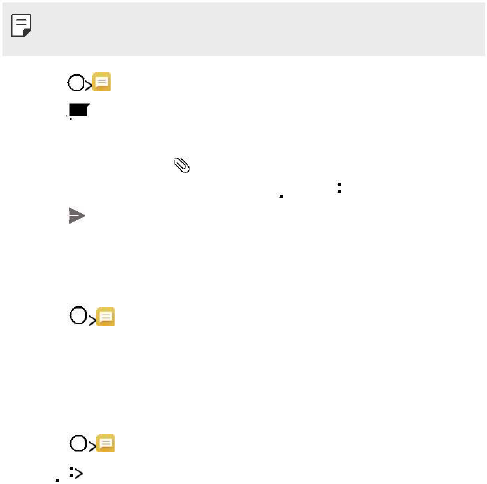
Messaging
Sending a message
You can create and send messages to your selected
contacts or all of your contacts using the Messaging app.
• Sending messages abroad may incur additional charges.
Consult with your service provider for more information.
1 Tap .
2 Tap .
3 Specify a recipient and create a message.
• To attach files, tap .
• To access optional menu items, tap .
4 Tap to send the message.
Reading a message
You can view exchanged messages organised by contact.
1 Tap .
2 Select a contact from the message list.
Configuring messaging settings
You can change messaging settings to suit your preferences.
1 Tap .
2 Tap Settings from the message list.
Useful Apps 49
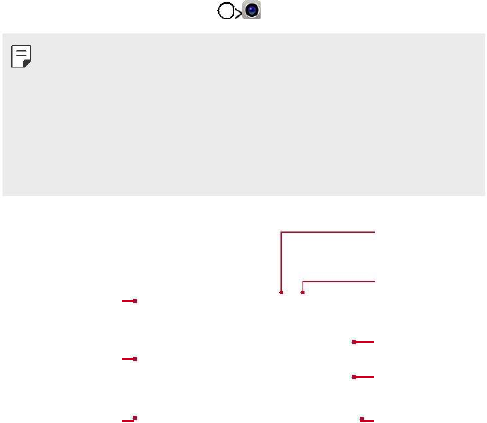
Camera
Starting the camera
You can take a photo or record a video to keep the
memorable moments. Tap .
• Before taking a photo, wipe the camera lens with a microfibre cloth. If
your finger touches the camera lens, you may get blurry photos.
• If the battery level is lower than 5%, charge the battery
before using the camera.
• Images included in this user guide may be different
from the actual device.
• Photos and videos can be viewed or edited from Gallery.
Turn the flash on
or off
Switch between
Select the Normal
front and rear
cameras
mode
Select the Face
Take photos
beauty mode
Record videos
Select the Panorama
Change camera
mode
options
Useful Apps 50
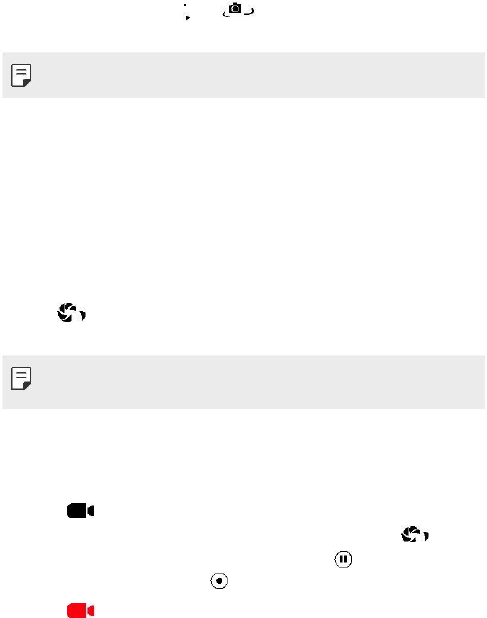
Switching between cameras
You can switch between the front and rear cameras to suit
your shooting environment.
On the camera screen, tap to switch between the
front and rear cameras.
• Use the front camera to take selfies.
Zoom in or out
You can use zoom in or out on the camera screen while
taking a picture or recording a video.
On the camera screen, pinch or spread two fingers to zoom in or out.
Taking a photo
1 Select a shooting mode, and tap the subject to focus the camera on.
2 Tap to take a photo.
Alternatively, press a volume key.
• When the screen is turned off or locked, start the camera
by pressing and holding the Volume.
Recording a video
1 Select the Normal mode, and tap the subject to focus the camera on.
2 Tap .
• To take a photo while recording a video, tap .
• To pause the video recording, tap . To resume the
video recording, tap .
3 Tap to end the video recording.
Useful Apps 51
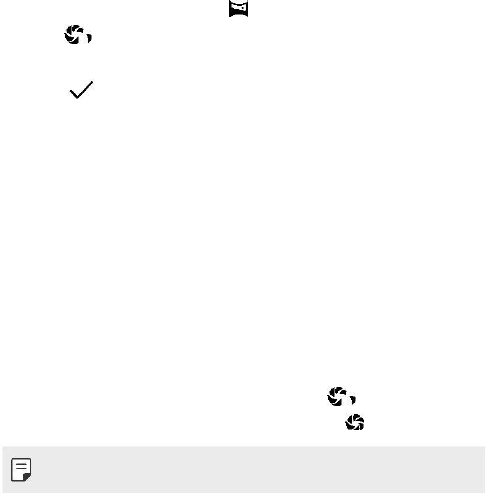
Panorama
You can create a panoramic photo by moving the camera in one
direction to photograph and stitch continuous shots of for a wide view.
1 In the Normal mode, tap .
2 Tap and then slowly move the camera in one direction.
• Move the device by following the direction of the arrow in the guideline.
3 Tap to end shooting.
Burst shot
You can take continuous shots of photos to create moving
pictures. In the Normal mode, tap and hold .
• Continuous shots are taken at a fast speed while is held down.
• Up to ten (10) continuous photos can be taken.
Useful Apps 52
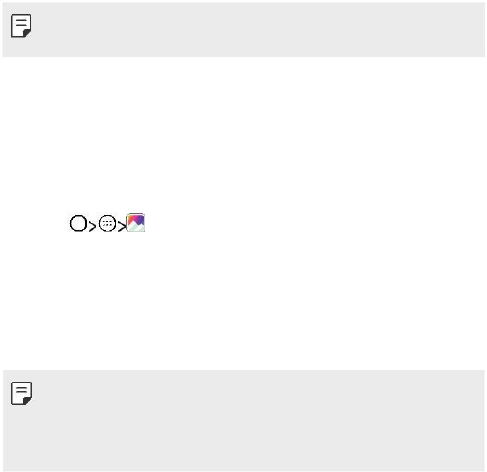
Taking selfies
You can use the front camera to view your face on the
screen and take selfies.
• When using the front camera, you can change in camera
options how selfies are taken.
Gallery
Gallery overview
You can view and manage photos and videos saved on your device.
1 Tap .
• Saved photos and videos are displayed by the folder.
2 Tap a folder and select a file.
• View the selected file in full-screen mode.
• Swipe left or right on the displayed photo or video
screen to view the previous or next file.
• Some file formats may not be supported, depending on
the installed software.
• Some files may not be opened due to encoding.
• Files that exceed the size limit may cause an error.
Useful Apps 53
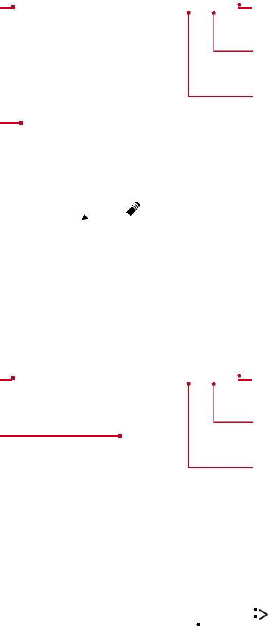
Viewing photos
Back to the previous
Access additional
screen
options
Share images via
Message
Share images
Edit images
Editing photos
1 While viewing a photo, tap .
2 Use a variety of effects and tools to edit the photo.
3 Tap SAVE to save changes.
• The changes are overwritten to the original file.
Playing a video
Back to the previous
Access additional
screen
options
Pause or play the
Share images via
Message
video
Share images
Deleting files
You can delete files by using one of the following options:
• Tap and hold a file from the file list, then tap Delete.
Useful Apps 54
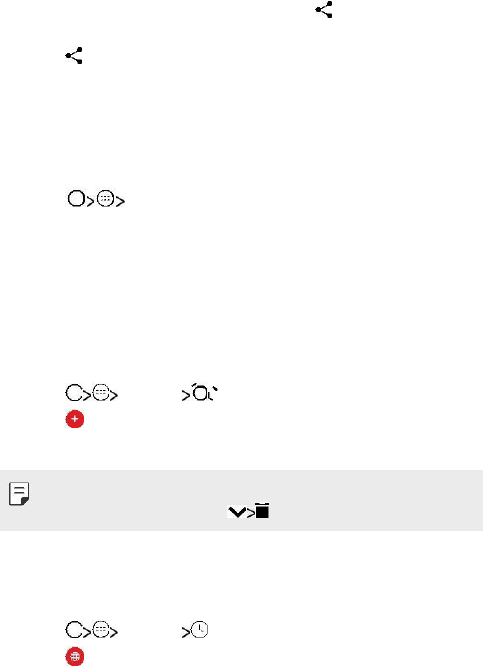
Sharing files
You can share files by using one of the following options:
• While viewing a photo or video, tap to share the file
by using the method you want.
• Tap from the file list to select files and share
them using the method you want.
File Manager
You can view and manage files saved on your device or cloud.
1 Tap File Manager.
2 Select the desired storage location.
Clock
Alarm
You can set an alarm to trigger it at a specified time.
1 Tap Clock .
2 Tap to add a new alarm.
3 Configure the alarm settings and tap OK.
• If you select a previously set alarm, you can edit the alarm.
• To delete an alarm, tap .
Clock
You can view the current time in cities around the world.
1 Tap Clock .
2 Tap and add a city.
Useful Apps 55
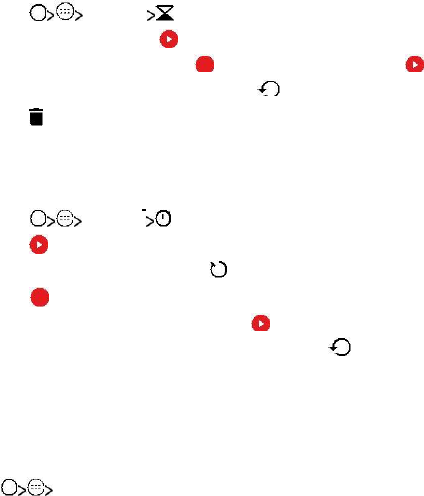
Timer
You can set the timer to trigger an alarm after a specified period of time.
1 Tap Clock .
2 Set the time and tap .
• To suspend the timer, tap . To resume the timer, tap .
• To reset the timer settings, tap .
3 Tap to reset the timer alarm.
Stopwatch
You can use the stopwatch to record a lap time.
1 Tap Clock .
2 Tap to initiate the stopwatch.
• To record a lap time, tap .
3 Tap to suspend the stopwatch.
• To resume the stopwatch, tap .
• To delete all the stopwatch records, tap .
Calculator
You can use two types of calculators: the simple
calculator and the scientific calculator.
Tap Calculator.
• To use scientific calculator, drag the slide bar
located in the right side of the screen to the left.
• To restart a calculation, touch and hold the DEL button.
Useful Apps 56
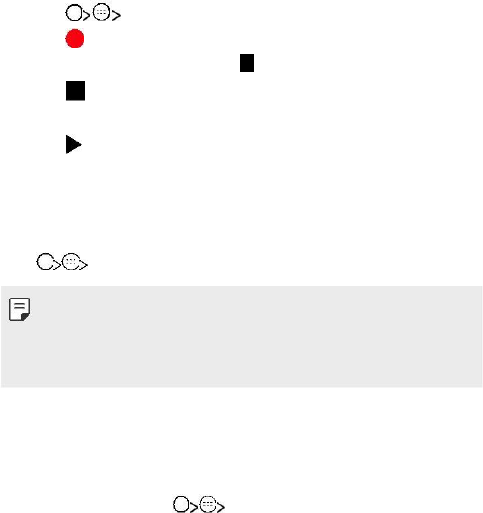
Sound Recorder
You can record and save your voice or others' voices from important
events. Recorded voice files can be played back or shared.
1 Tap Sound Recorder.
2 Tap .
• To pause recording, tap .
3 Tap to end recording.
• The file is saved automatically and the pre-listen screen appears.
4 Tap to play the recorded voice.
FM Radio
You can listen to FM radio.
Tap FM Radio.
• To use this app, first connect a headset to the device.
The headset becomes the radio antenna.
• This option may not be supported, depending on the area.
• The headsets will continue to play sound even in Speaker Mode.
Downloads
You can view, delete or share files downloaded via the
Internet or apps. Tap Downloads.
Useful Apps 57
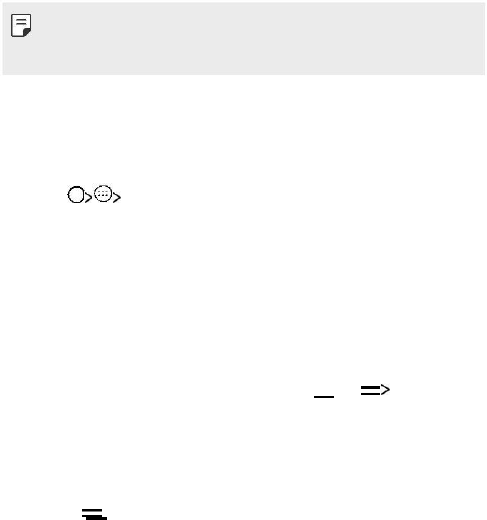
E-mail
E-mail overview
You can register an email account to your device and then
you can check and send emails from your device.
• If you use mobile data, you may be charged for data
usage fee depending on your pricing plan. Consult with
your service provider for more information.
Registering email accounts
When you use the email app for the first time, register
your email account.
1 Tap E-mail.
2 Select an email service provider.
3 Enter your email address and password and then
tap NEXT to register your account
• To manually register an email account or to register email
accounts not found in the list, tap MANUAL SETUP.
Managing email accounts
To view or edit your email account settings, tap Settings.
• To add an account, tap Add account.
Opening another email account
If several email accounts are registered and you want to view another
account, tap and select another one from the account list.
Useful Apps 58
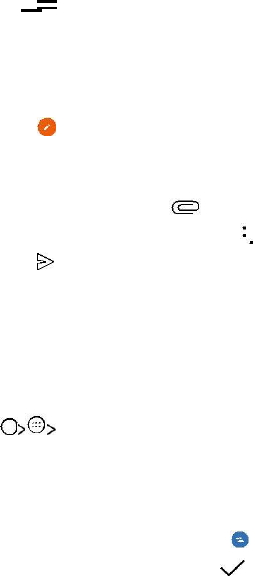
Checking email
1 Tap and select a mail box.
2 Select an email from the email list.
• The email message appears.
Sending email
1 Tap .
2 Enter the email address of a recipient.
3 Enter a subject and message.
• To attach files, tap .
• To access optional menu items, tap .
4 Tap to send the email.
Contacts
Contacts overview
You can save and manage contacts.
Tap Contacts.
Adding contacts
Adding new contacts
1 On the contact list screen, tap .
2 Enter contact details and tap .
Useful Apps 59

Importing contacts
You can import contacts from another storage device.
1 On the contact list screen, tap Import/Export.
2 Select the source and target locations of the contact
you want to import, and then tap NEXT.
3 Select contacts and tap OK.
Searching for contacts
You can search for contacts by using one of the following options:
• On the contact list screen, enter a contact name in the search box.
• Scroll the contact list up or down.
• From the index of the contact list screen, tap the
initial letter of a contact.
Contacts list
Editing contacts
1 On the contact list screen, select a contact.
2 On the contact detail screen, tap and edit details.
3 Tap to save changes.
Deleting contacts
1 On the contact list screen, tap and hold a contact.
2 Tap Delete.
Adding favourites
You can register frequently used contacts as favourites.
1 On the contact list screen, select a contact.
2 On the contact detail screen, tap .
Useful Apps 60
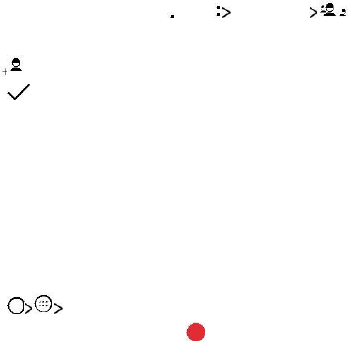
Creating groups
1 On the contact list screen, tap Groups .
2 Enter a new group name.
3 Tap , select contacts, then tap OK.
4 Tap to save the new group.
Calendar
Calendar overview
You can use the calendar to manage events and tasks.
Adding events
1 Tap Calendar.
2 Select a date and then tap .
3 Enter event details and tap SAVE.
• If you tap a date from the calendar and the date contains events,
a pop-up window appears showing a list of the events. Tap an
event from the pop-up window to view the event details.
Useful Apps 61

Google apps
You can use Google apps by setting a Google account. The Google account
registration window appears automatically when you use a Google app for the
first time. If you do not have a Google account, create one from your device.
For details on how to use an app, see the Help in the app.
• Some apps may not work depending on the area or service provider.
Google
Use search function provided by Google to search web sites and
files stored on your device by entering keywords or via voice.
Gmail
Register your Google email account to your device to check or send email.
Maps
Find your location or the location of a place on the
map. View geographical information.
YouTube
Search and play videos. Upload videos on YouTube to
share them with people around the world.
Drive
Upload, save, open, share and organise files from your device. Files accessible from apps
can be accessed from anywhere, including online and offline environments.
Play Music
Purchase music files from Play Store. Play music files
saved on your device.
Useful Apps 62
Play Movies & TV
Use your Google account to rent or purchase movies.
Purchase content and play it anywhere.
Photos
View or share photos or albums saved on your device.
Useful Apps 63

04
Phone Settings

Settings
You can customise the device settings in
accordance with your preferences.
Tap Settings.
• Tap and enter a keyword in the search box to access a setting item.
Wireless & networks
Wi-Fi
You can connect to nearby devices over a Wi-Fi network.
Connecting to a Wi-Fi network
1 On the settings screen, tap Wi-Fi.
2 Drag to activate it.
• Available Wi-Fi networks appear automatically.
3 Select a network.
• You may need to enter the network's Wi-Fi password.
• The device skips this process for previously accessed
Wi-Fi networks. If you do not want to automatically
connect to a certain Wi-Fi network, tap and hold the
network and then tap Forget network.
Wi-Fi network settings
On the settings screen, tap Wi-Fi.
• : Customise Wi-Fi network settings.
Phone Settings 65
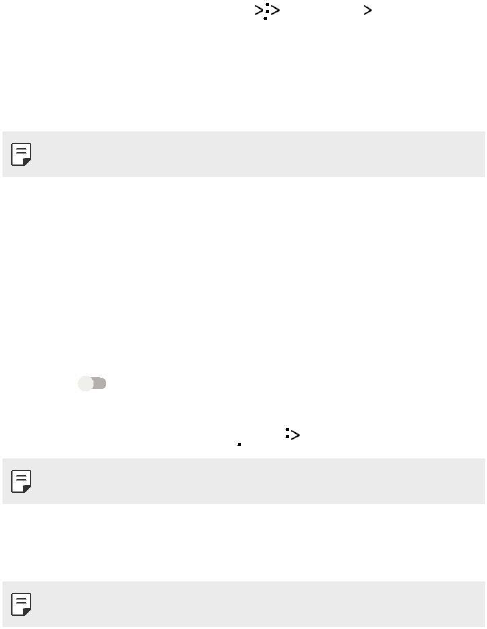
Wi-Fi Direct
You can connect your device to other devices that support Wi-Fi Direct to
share data directly with them. You do not need an access point. You can
connect with more than two devices by using Wi-Fi Direct.
1 On the settings screen, tap Wi-Fi Advanced Wi-Fi Direct.
• Nearby devices that support Wi-Fi Direct automatically appear.
2 Select a device.
• Connection occurs when the device accepts the
connection request.
• The battery may drain faster when using Wi-Fi Direct.
Bluetooth
You can connect your device to nearby devices that support Bluetooth
to exchange data with them. Connect your device to a Bluetooth
headset and a keyboard. This makes it easier to control the device.
Pairing with another device
1 On the settings screen, tap Bluetooth.
2 Drag to activate it.
• Available devices appear automatically.
• To refresh the device list, tap Refresh.
• Only devices with the searching option enabled are displayed on the list.
3 Select a device from the list.
4 Follow the on-screen instructions to perform authentication.
• This step is skipped for previously accessed devices.
Phone Settings 66
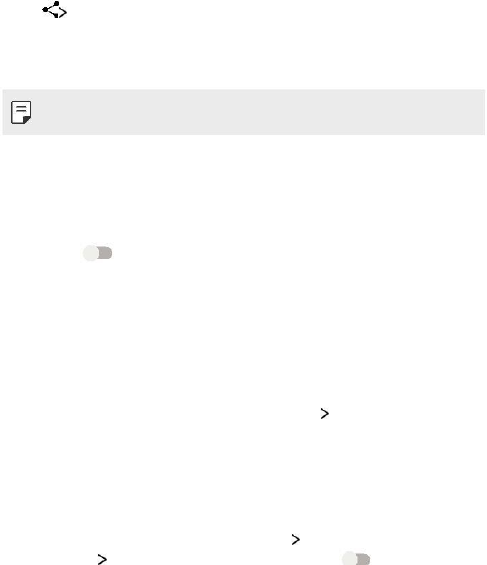
Sending data via Bluetooth
1 Select a file.
• You can send multimedia files or contacts.
• Bluetooth.
2 Select a target device for the file.
• The file is sent as soon as the target device accepts it.
• File sharing processes may differ depending on the file.
Data usage
Displays the data usage and device data usage limit.
On the Settings screen, tap Data usage.
• Tap to toggle your device data connection On or
Off. This allows you to manage your device data usage.
You can use a Wi-Fi network connection for data instead.
Airplane mode
You can turn off the call and mobile data functions. When this mode is on,
functions that do not involve data, such as games and music playback,
remain available. On the settings screen, tap More Airplane mode.
Wi-Fi hotspot
You can set the device as a wireless router so that other devices
can connect to the internet by using your device’s mobile data.
1 On the settings screen, tap More Tethering & portable
hotspot Wi-Fi hotspot and then drag to activate it.
2 Tap Set up Wi-Fi hotspot, and enter the Network
Name and password.
3 Turn on Wi-Fi on the other device, and select the name
of the device network on the Wi-Fi list.
Phone Settings 67
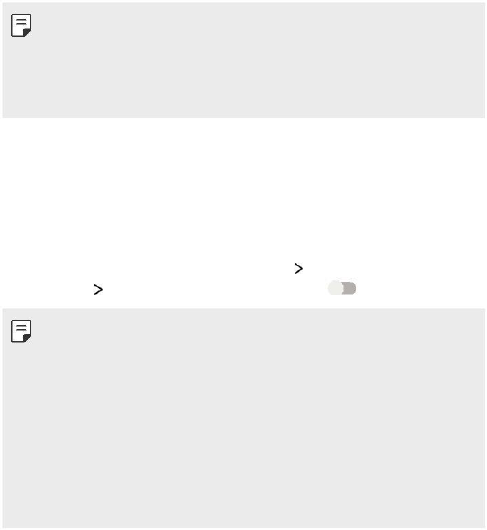
4 Enter the network password.
• This option uses mobile data and may incur data usage
fees, depending on your pricing plan. Consult with your
service provider for more information.
• More information is available at this web
site: http://www.android.com/tether#wifi
USB tethering
You can connect the device to another device via USB
and share mobile data.
1 Connect your device and other devices via USB cable.
2 On the settings screen, tap More Tethering & portable
hotspot USB tethering and then drag to activate it.
• This option uses mobile data and may incur data usage
fees, depending on your pricing plan. Consult with your
service provider for more information.
• When connecting to a computer, download the USB
driver from www.lg.com and install it on the computer.
• You cannot send or receive files between your device
and a computer while USB tethering is turned on. Turn
off USB tethering to send or receive files.
• Operating systems that support tethering are Window
XP or higher, or Linux.
Phone Settings 68
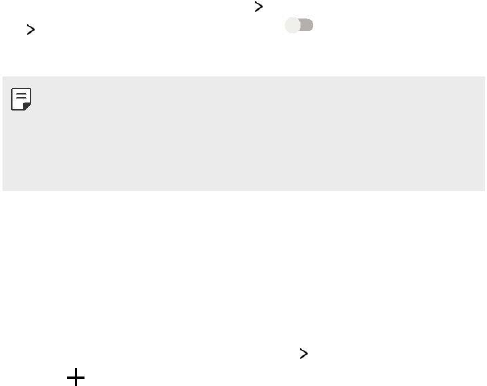
Bluetooth tethering
A Bluetooth-connected device can connect to the internet
by using your device's mobile data.
1 On the settings screen, tap More Tethering & portable hotspot
Bluetooth tethering and then drag to activate it.
2 Turn on Bluetooth on both devices, and pair them.
• This option uses mobile data and may incur data usage
fees, depending on your pricing plan. Consult with your
service provider for more information.
• More information is available at this web site:
http://www.android.com/tether#Bluetooth_tethering
VPN
You can connect to a safe virtual network, such as an intranet.
You can also manage connected virtual private networks.
Adding VPN
1 On the settings screen, tap More VPN.
2 Tap .
• If the screen is not locked, a notification screen appears.
Tap OK from the notification screen and lock the screen.
3 Enter VPN details and tap SAVE.
Configuring VPN settings
1 Tap a VPN from the VPNS list.
2 Enter the VPN user account details and tap CONNECT.
Phone Settings 69

Mobile networks
You can customise mobile data settings.
1 On the settings screen, tap More Mobile networks.
2 Customise the following settings:
• Data roaming: Connect to data services when roaming.
• Preferred network type: Select a network type.
• Access Point Names: View or change the access point
for using mobile data services. To change the access
point, select a choice from the access point list.
• Network operators: Search for network operators
and connect automatically to a network.
Device
Display
You can customise detailed settings for each screen type.
On the settings screen, tap Display and customise the following settings:
• Wallpaper: Change the Home screen background theme.
• Lock screen wallpaper: Set your Lock screen wallpaper.
• Brightness level: Use the slide bar to change the
device’s screen brightness.
• Adaptive brightness: Set the device so that the
screen brightness is automatically adjusted in
accordance with the surrounding light intensity.
• Sleep: Automatically turn off the screen when the
device is left idle for a specified period of time.
• Daydream: Display a screen saver when the device is connected to
the holder or charging. Select a screen saver type to display.
• Font size: Change the font size.
Phone Settings 70

• When device is rotated: Automatically rotate the screen
according to the device’s orientation.
• More KnockON: Turn on or off the screen by
tapping the screen twice.
Sound & notification
You can customise sound, vibrate and notification settings.
On the settings screen, tap Sound & notification and
customise the following settings:
• Sound: Adjust the sound volume for various items.
• Also vibrate for calls: Set the device to vibrate and
play a ringtone simultaneously.
• Do not disturb: Set the time, range and app type to
receive notification messages. Receive notification
messages only on particular days of the week.
• Phone ringtone: Select a ringtone for incoming calls.
• Default notification ringtone: Select a notification ringtone.
• Other sounds: Select a sound effect to play when you tap
the dial pad, select an option, or lock or unlock the screen.
• When device is locked: Display or hide a notification
message on the lock screen.
• App notifications: Select the apps that can show their
notification messages on the screen, and set the priorities of
those apps in regard to notification messages.
• Notification access: Apps cannot read notifications.
• Do Not Disturb access: Limit interruptions with Do not disturb mode.
Phone Settings 71

Apps
You can view a list of installed apps. Shut down or
delete apps, if necessary.
1 On the settings screen, tap Apps.
2 Select an app and perform actions.
Storage
You can view and manage internal storage on the device or
storage space of the memory card.
1 On the settings screen, tap Storage.
2 Customise the following settings:
• Device storage : View the total storage space and free
space in the device’s internal storage. View a list of
apps in use and the storage capacity for each app.
• Portable storage: View the total storage space and free space
in the memory card. This option appears only when a memory
card is inserted. To unmount the memory card, tap .
Battery
You can view the current battery information or turn on battery saver.
1 On the settings screen, tap Battery.
2 Customise the following settings:
• Use details : View the battery usage details. To view
more details, select a specific item.
• Battery saver: Reduce battery consumption by
cutting down some device settings, such as the
display brightness, speed and vibration intensity. The
status bar displays when battery saver is on.
Phone Settings 72

Memory
You can view the average amount of memory usage over a
certain period of time and the memory occupied by an app.
1 On the settings screen, tap Memory.
2 Tap to set a time slot to retrieve data.
Personal
Location
You can customise how your location information is used
by particular apps.
1 On the settings screen, tap Location.
2 Customise the following settings:
• Mode: Select a method to provide your location information.
• Recent location requests: View apps that
recently requested location information.
• Google Location History: Configure the Google
location history settings.
Security
1 On the settings screen, tap Security.
2 Customise the following settings:
• Screen lock: Customise lock screen settings.
• Automatically lock: Automatically turn off the screen
when the device is left idle for a specified period of time.
• Power button instantly locks: Instantly lock the
screen when the Power/Lock key is pressed.
• Lock screen message: Display message on the lock screen.
Phone Settings 73
• Smart Lock: Select trusted items so that if one of them
occurs, the device is automatically unlocked.
• Encrypt phone: Set the device password for privacy. Create a
PIN or password to enter each time the device is turned on.
• Set up SIM card lock: Lock or unlock the SIM card,
or change the password (PIN).
• Make passwords visible: Display a password as you enter it.
• Device administrators: Allow privileges to restrict
the control or use of the device to particular apps.
• Unknown sources: Allow the installation of apps
from non-Play Store apps.
• Storage type: Displays the current storage type.
• Trusted credentials: Display trusted CA certificates.
• Install from internal storage: Tap to install a secure certificate.
• Clear credentials: Remove all certificates.
• Trust agents: View and use trust agents installed on the device.
• Screen pinning: Fix the app screen so that only the
currently active app can be used.
• Apps with usage access: View details on usage of
apps on the device.
Accounts
You can add or manage accounts, including a Google account. You
can also sync particular apps or user information automatically.
1 On the settings screen, tap Accounts.
2 Customise the following settings:
• Auto-sync data: Sync all the registered accounts automatically.
• Add account: Add accounts.
Phone Settings 74
Google
You can use Google settings to manage your Google
apps and account settings.
On the settings screen, tap Google.
Language & input
You can customise language and keyboard settings for your device.
1 On the settings screen, tap Language & input.
2 Customise the following settings:
• Language: Select a language to apply for the device.
• Spell checker: Correct the spelling by using Google Spell Checker.
• Personal dictionary: Manage some words in
the Personal dictionary.
• Current Keyboard: View the keyboard type currently
in use. Select a keyboard to use when entering text.
• Android Keyboard (AOSP): Customise Android keyboard settings.
• Google voice typing: Configure the options for text
dictation by Google.
• Text-to-speech output: Configure the settings for
text-to-speech output.
• Pointer speed: Adjust the pointer speed of a mouse or trackpad.
Backup & reset
You can back up data saved on your device to another
device or account. Reset the device, if necessary.
1 On the settings screen, tap Backup & reset.
2 Customise the following settings:
• Back up my data: Back up your app data, Wi-Fi
password and other settings to the Google server.
• Backup account: View the current backup account in use.
Phone Settings 75

• Automatic restore: Automatically restore backup
settings and data when reinstalling an app.
• Network settings reset: Reset Wi-Fi, Bluetooth
and other network settings.
• Factory data reset: Reset all settings for the device
and delete data.
• Resetting your device deletes all data on it. Enter your device
name, Google account and other initial information again.
System
Date & time
You can customise date and time settings for your device.
1 On the settings screen, tap Date & time.
2 Customise the settings.
Accessibility
You can manage accessibility plug-ins installed on your device.
1 On the settings screen, tap Accessibility.
2 Customise the following settings:
• TalkBack: Set the device to notify screen status
or actions via voice.
• Switch Access: Create key combinations to control your device.
• Captions: Turn on the subtitle service when playing
videos for the hearing impaired.
• Magnification gestures: Zoom in or out by tapping
the screen three times.
• Large text: Change the font size.
Phone Settings 76
• High contrast text: Set the text to a darker contrast.
• Power button ends call: End a call by pressing the
Power/Lock Key.
• Auto-rotate screen: Automatically change the screen
orientation according to the physical position of the device.
• Speak passwords: Enable to allow voice confirmations
of characters when entering passwords.
• Accessibility shortcut: Quickly access a frequently used function.
• Text-to-speech output: Set the preferred speech
engine and speech rate.
• Touch & hold delay: Adjust the touch input time.
• Colour inversion: Increase the display colour
contrast for people with low vision.
• Colour correction: Adjust the display colour.
Printing
You can print the content of certain screens (such as web
pages displayed in Chrome) to a printer connected to the
same Wi-Fi network as your Android device.
About phone
You can view information about your device, such as the
name, status, software details and legal information.
On the settings screen, tap About phone and view information.
Phone Settings 77

05
Appendix
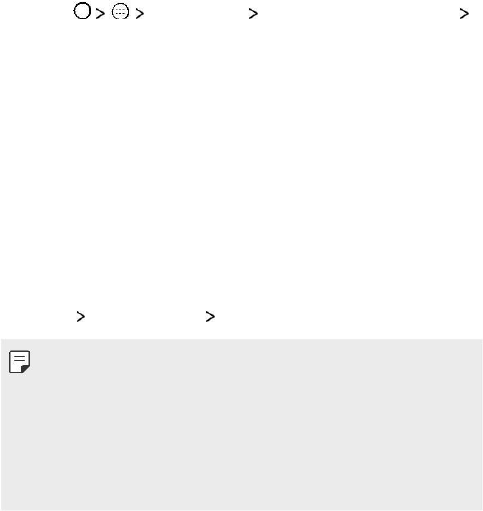
LG Language Settings
Select a language to use on your device.
• Tap Settings Language & input
Language, and select a language.
Phone software update
LG Mobile Phone software update via
Over-the-Air (OTA)
This feature allows you to conveniently update your phone’s
software to a newer version via OTA, without connecting using a
USB cable. This feature will only be available if and when LG
makes a newer firmware version available for your device.
First check the software version on your mobile phone:
Settings About phone System updates.
• Your personal data from internal phone storage—including information
about your Google account and any other accounts, your system/
application data and settings, any downloaded applications and your
DRM licence—might be lost in the process of updating your phone’s
software. Therefore, LG recommends that you backup your personal
data before updating your phone’s software. LG does not take
responsibility for any loss of personal data.
• This feature depends on the area or service provider.
Appendix 79
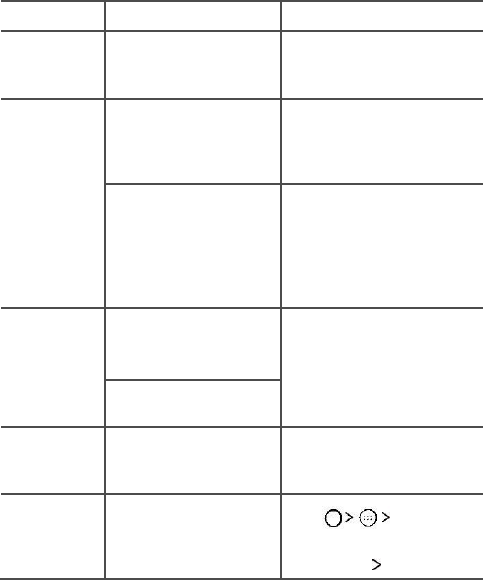
FAQ
This chapter lists some problems you might encounter
when using your phone. Some problems require you to call
your service provider, but most are easy to fix yourself.
Message
Possible causes
Possible corrective measures
There is no SIM card in
Make sure the SIM card is
SIM card error
the phone or it is inserted
correctly inserted.
incorrectly.
Signal is weak or you
Move toward a window or
into an open area. Check the
are outside the carrier
network operator coverage
network.
No network
map.
connection/
Check whether the SIM card is
Dropped
more than 6~12 months old.
network
Operator applied new
If so, change your SIM at your
services.
network provider's nearest
branch. Contact your service
provider.
To change a security code,
Codes do not
confirm the new code by
If you forget the code, contact
re-entering it.
match
your service provider.
The two codes you entered
do not match
No
Not supported by service
applications
provider or registration
Contact your service provider.
can be set
required.
Downloaded
1. Tap
Settings.
application
Remove the application.
2. Tap the
Apps
.
causes a lot of
3. Tap the app
UNINSTALL
.
errors.
Appendix 80

Message
Possible causes
Possible corrective measures
Dialling error
New network not authorised.
Calls not
New SIM card inserted.
Check for new restrictions.
available
Pre-paid charge limit
Contact service provider or
reached.
reset limit with PIN2.
On/Off key pressed too
Press the On/Off key for at least
Phone cannot
briefly.
two seconds.
Charge battery. Check the
be turned on
Battery is not charged.
charging indicator on the
display.
Battery is not charged.
Charge battery.
Outside temperature is too
Make sure phone is charging at
hot or cold.
a normal temperature.
Contact problem
Check the charger and its
connection to the phone.
Charging error
No voltage
Plug the charger into a different
outlet.
Charger defective
Replace the charger
Wrong charger
Use only original LG accessories.
Impossible to
Delete some data, such as
applications or messages from
receive/ send
Memory full
your phone to make more
SMS & photos
memory available.
Appendix 81
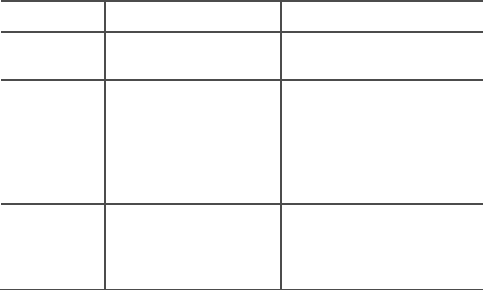
Message
Possible causes
Possible corrective measures
Files do not
Unsupported file format
Check the supported file
open
formats.
If you use a protection tape
The screen
or case, make sure it has not
does not turn
Proximity sensor problem
covered the area around the
on when I
proximity sensor. Make sure that
receive a call.
the area around the proximity
sensor is clean.
Check the settings status in the
No sound
Vibration mode
sound menu to make sure you
are not in vibration or Do not
disturb mode.
Appendix 82

Anti-Theft Guide
Set up your device to prevent other people from using it if it's been
reset to factory settings without your permission. For example, if
your device is lost, stolen, or wiped, only someone with your
Google account or screen lock information can use the device.
All you need to make sure your device is protected is:
• Set a screen lock: If your device is lost or stolen but you
have a screen lock set, the device can't be erased using
the Settings menu unless your screen is unlocked.
• Add your Google account on your device: If your device is wiped but
you have your Google account on it, the device can't finish the setup
process until your Google account information is entered again.
After your device is protected, you'll need to either unlock your screen
or enter your Google account password if you need to do a factory
reset. This ensures that you or someone you trust is doing the reset.
• Do not forget your Google account and password you had added to
your device prior to performing a factory reset. If you can't provide the
account information during the setup process, you won't be able to use
the device at all after performing the factory reset.
Appendix 83
More information
Open Source Software Notice Information
To obtain the source code under GPL, LGPL, MPL,
and other open source licenses, that is contained in
this product, please visit http://opensource.lge.com.
In addition to the source code, all referred license terms, warranty
disclaimers and copyright notices are available for download.
LG Electronics will also provide open source code to you on CD-ROM
for a charge covering the cost of performing such distribution (such as
the cost of media, shipping, and handling) upon email request to
opensource@lge.com. This offer is valid for three (3) years
from the date on which you purchased the product.
Trademarks
• Copyright © 2017 LG Electronics, Inc. All rights reserved. LG and the LG
logo are registered trademarks of LG Group and its related entities.
• Google™, Google Maps™, Gmail™, YouTube™, Hangouts™
and Play Store™ are trademarks of Google, Inc.
• Bluetooth® is a registered trademark of Bluetooth SIG, Inc. worldwide.
• Wi-Fi® and the Wi-Fi logo are registered trademarks
of the Wi-Fi Alliance.
• All other trademarks and copyrights are the
property of their respective owners.
Appendix 84
